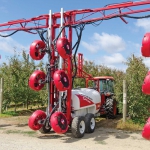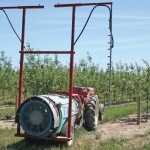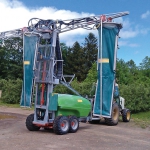As more growers move toward modern, high-density planting systems to improve yield and orchard management, the sprayer output needs to be matched to the modern canopy. The closely planted trees of today’s modern orchard require totally different management than the large, traditional tree canopies of older orchards.
Many growers have increased the number of rows per acre but have not changed the style or number of sprayers to match the increased productivity required. As fruit growers face reduced numbers of field workers, the vagaries of the market, and a need for improved productivity in modern orchards, the major challenge of spraying timeliness rises to the top of orchard management.
Multi-row sprayers
Spraying both sides of the canopy at the same time can increase deposition by up to 50 percent compared with single-sided spraying, while improving uniformity of distribution within the canopy and limiting losses of spray onto the ground.
More manufacturers are now offering some form of multi-row sprayer, usually based upon a gantry with numerous fans or outlets spraying horizontally into the canopy. Most multi-row sprayers utilize modern technology such as tracking drawbars, strainer/mixer and tank rinsing, and some, of particular interest, have the ability to alter fan speed for varying canopy conditions (density and growth stage). High-output hydraulics can ensure rapid folding of the gantry system.
Multi-row sprayers improve output by allowing better use of ideal spraying conditions, better timeliness, and fewer tractor/labor hours per acre. Multi-row sprayers reduce the number of passes over the ground, reducing compaction along many rows and confining compaction to the occasional row of travel.
A multi-row sprayer design must be carefully studied; the strength of the gantry or frame system, the time to fold the gantry for transport and turning, and the space required for headland turning are all important considerations. Many orchards don’t have enough headland space to enable a wide multi-row sprayer to turn easily, so a number of growers are settling on the two- or three-row models.
Growers should be aware when purchasing a multi-row sprayer that a two-row sprayer compared to a single-row sprayer doesn’t double output. Overall workrate may improve by 75 to 80 percent, depending upon logistical support, etc. Three-row models are designed where two rows are sprayed from both sides and two outer rows are sprayed one-side only. Trials show that when trees are sprayed from both sides simultaneously, coverage is much better, due to improved air turbulence, than when outer rows are sprayed from one side only.
Vertical boom sprayer
With the narrow canopy of spindle trees on a modern trellis, some growers question the need for any air-assistance and have designed and built their own multi-row sprayers. They have constructed a simple gantry with vertical booms and nozzles that rely on pressure, around 150 pound force per square inch, to provide spray
penetration into the canopy.
With good break-back systems, three- and four-row sprayers can be used with great success in many conditions. Early season spraying, when there is little canopy and conditions can be windy, provides a challenge when no air-assistance is available to combat the on-coming wind.
Vertical air sleeve sprayer
Munckhof, a sprayer manufacturer in the Netherlands, offers a three-row vertical air sleeve sprayer, which is being imported into the United States by LaGasse Works of Lyons, New York. It comprises three individual tapered air sleeves mounted on a gantry. Small hydraulically driven fans provide the airflow to inflate the sleeves and the air then passes through a vertical slit carrying droplets from the nozzles to the tree canopy.
The gantry is hydraulically adjustable for row widths from 9.5 to 13 feet and can be used in trees up to 13 feet tall. The sprayer has its own oil reservoir and pump system but unfortunately provides no variation in fan speed. In New York, one orchardist has two of these high output sprayers (see photo). Air assistance, provided by inflatable sleeves, has been popular on horizontal boom sprayers in field crops and has a proven record of longevity.
The air-assisted sprayer
The Hol Spraying System, also from the Netherlands, uses flexible ducts to carry air from a radial fan to small fish-tail distribution outlets next to the nozzles. The air outlets can be mechanically adjusted in height and angle to direct the air toward the canopy. The sprayer is adjustable for row widths up to 12 feet and trees up to 11.5
feet tall. The three-row model is being imported from the Netherlands to Beamsville, Ontario, Canada, by ProvideAgro, part of N.M. Bartlett.
Tunnel sprayers
Tunnel sprayers straddle the canopy to form a three-sided tunnel that encases both sides and the top of the tree. Two vertical spray booms, fitted with hydraulic nozzles, are located on opposite sides of the tunnel. Spray is directed into the canopy, and any excess spray that passes through the trees may be captured on the inside of the tunnel walls and re-circulated via filters into the sprayer tank.
Recycling spray material reduces the amount of pesticide used per acre by an average of 30 percent over the season and improves logistics by allowing the sprayer to travel greater distances per tank load. Pesticide reduction is greatest in the pre-bloom season (up to 85 percent recycling). In orchards, a reduction in drift of 90 percent relative to airblast sprayers has been documented for tunnel sprayers, which represent the best drift-reducing spray technology currently available. If air inclusion nozzles are used with the tunnel sprayer, 95 percent drift reduction can be attained.
It is very important to note that if fire blight (Erwinia amylovora) is present in the orchard or region, it is not wise to use the recycling feature of the tunnel sprayer. An unpublished Cornell University research trial confirms that spray can wash the bacteria off the plant surfaces and then be recycled into the tank and subsequently sprayed onto healthy trees.
Compared with the large spray plume created by an airblast sprayer, the lack of visible spray discharge beyond the tunnel enclosure may reduce public concerns about pesticide application.
Operation on very uneven or sloping terrain can be problematic for tunnel sprayers. However, tunnel sprayers allow spraying to take place in windy conditions.
The LIPCO tunnel sprayer has a plastic tunnel mounted on a frame that encloses the tree canopy during spraying. A tangential or cross-flow fan mounted inside the tunnel wall on each side of the tunnel provides airflow to aid spray penetration. Lightweight plastics and well-designed hitches allow a fair degree of maneuverability. The tunnel will work in 9 to 11 feet wide rows, with a maximum canopy width of 7.2 feet and height of 11.5 feet.
Multi-head fan systems
The Proptec sprayer uses a rotary cage to create droplets that can be directed into the canopy. Liquid is fed into a high-speed, hydraulically driven spinning cage, where centrifugal forces spread the liquid and throw it from the periphery. The majority of droplets (about 95 percent) are the same size, depending upon flow rate and cage speed. A small fan provides air movement and the position of the unit on the frame or gantry dictates air direction.
The cage and fan assemblies can be mounted on a vertical tower or a horizontal gantry, thus placing them next to, or above, the trees.
Changing the speed of the fans, to reduce airflow and drift in the sparse canopies of early season, increases the size of the droplets. Larger droplets bounce off the leaves and this is regarded by some as a limitation of controlled-droplet sprayers when compared to other multi-fan sprayers that do allow changes in fan speed independent of nozzle and droplet size.
One fruit grower in New York has successfully used this sprayer, fitted with three fans on each side of a vertical mast, for alternate row spraying of apple trees for the past ten years, applying 60 GPA all season.
The GreenTech and Croplands Quantum Mist multi-head sprayer are made in Australia and exported to a number of regions, including North America. They are comprised of a series of fan units mounted on a tower or frame that surrounds the tree canopy. Hydraulic fan or cone nozzles are mounted in front of the fans, and the airflow directs the droplets toward the canopy. The diagonally opposed fans create good turbulence and deposition within the canopy. The fans were originally designed at SARDI, Loxton, Australia.
On the GreenTech sprayer, the fans are driven by electric motors, with power supplied from a tractor PTO-driven generator. On the Croplands Quantum Mist, the fans are driven either by hydraulic motors or by a combination of hydraulic motor and cable drive. The Croplands Quantum Mist will work in rows up to 11.5 feet wide and trees up to 13 feet tall.
In the United States, manufacturers such as VineTech and Blueline mount the SARDI fans on a vertical mast or frame, or on a gantry surrounding the canopy; the gantry arms are adjustable to match different row widths. Depending upon the make or model, three to five fans can be deployed to give excellent airflow and penetration into the canopy. The fan angle is adjustable. Fan speed is also adjustable, allowing airflow to match the developing canopy. Both companies are very progressive in the field of application technology.
Remember that to obtain the best from these larger machines, as with all high-output systems, the grower will need excellent spraying logistics, such as rapid filling, perhaps a nurse tank in the field, and a skilled operator. As with all good farm management, attention to detail is key.
Multi-row sprayers offer many advantages for the modern orchardist, but above all they provide improved timeliness, fewer operators and tractors, and therefore less responsibility for management.
====
Videos and further specifications on the machines mentioned in this article maybe found at the links below:
Proptec design:
www.bluelinemfg.com
www.curtecsprayers.com
www.ledebuhr.net
SARDI fans design:
www.croplands.com.au
www.greentechspraysystem.com
www.vinetechequipment.com
Tunnel sprayer design:
www.vineyardmachines.com
www.vinetechequipment.com
www.lipco.com
Vertical airsleeve design:
www.lagasseworks.com
www.munckhof.org
Air-assisted design:
www.provideag.ca
www.holsprayingsystems.com









Gracias Christophe,
Por el articulo, muy interesante.
Atentamente.
Vicente Cucala,
Orchard Sprayers and Vineyard Sprayers. We at MITRA are manufacturing world-class Orchard Sprayers, Vineyard Sprayers suitable for all type of planting patterns.